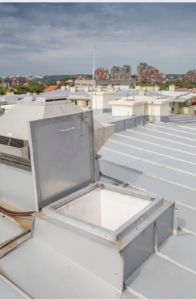Whether individuals access the roof for maintenance or to install or remove equipment, they must do so safely. It is why hatches come in a wide range of sizes.
The size needed is determined by the frequency and reason for accessing the roof area. Hatches can also have railing systems to protect workers as they move through the opening. For more information about the roof access hatches regulations, click here.
Safety
 A roof access hatch provides a safe way to enter and exit the roof. It helps prevent injuries by reducing the need to climb multiple floors to reach the top.
A roof access hatch provides a safe way to enter and exit the roof. It helps prevent injuries by reducing the need to climb multiple floors to reach the top.
Safety regulations require any rooftop opening, including roof hatches, to have guardrails to protect anyone working on a rooftop. It is the only form of fall protection that is acceptable, and personal falling arrest systems and netting are not allowed.
The stipulations regarding roof hatch safety are strict and should not be disregarded by building owners. They must work with a manufacturer to ensure that the specifics of their chosen solution meet Canadian and Quebec building standards and that their Risk Assessments are comprehensive and support the safe use of the system in question. In addition, the manufacturer should be able to provide additional options for safety, such as increased opening sizes and motorised solutions.
Ease of Use
Roof access hatches used to enter and exit rooftop equipment or structures must provide additional ease of use measures. These may include a ladder safety post designed to permanently mount to the top two rungs of the fixed ladder and provide an extra handhold for stability. For more information about the roof access hatches regulations, click here.
The frequency and purpose of a building’s rooftop access will also impact the type of roof hatch required. For instance, a larger hatch with a ship or service stair will be necessary to enter large equipment, such as an MRI machine, in hospital buildings.
Hatches used as emergency exits from a building must be large enough for firefighters wearing full gear to fit through. Fortunately, there are many options for meeting these requirements. For example, a standard roof hatch can be designed with interior and exterior padlock hasps and contact switches that can be wired to the building’s alarm system control panel. Special finishes are also available from hatch manufacturers for added corrosion resistance or to allow a hatch to match a building’s facade.
Aesthetics
Many hatches feature a low profile and an insulated design that improves energy efficiency by lowering heating and cooling costs. They also provide superior acoustic insulation and have a U value of up to 0.68 W/(m2K). Some manufacturers even offer customisation options to help builders blend the new roof access door into existing ceiling designs.
Ladder access roof hatches make it easier for technicians to repair and install HVAC systems, solar panels, or lighting fixtures on a building’s roof. They are more stable than unsteady exterior ladders and reduce workers’ risk of injury. They can also be customised with louvres for ventilation, reducing energy costs. These features are especially useful in buildings with low sunlight. For more information about the roof access hatches regulations, click here.
Sustainability
Roof access hatches are essential for providing safe rooftop access to service personnel for the installation and maintenance of HVAC equipment, as well as other building-related activities. However, open roof hatches can pose a fall hazard for personnel if they aren’t appropriately secured. It is a severe liability concern for building owners, and the result can be debilitating injuries or even death.
In ensuring a safe and reliable roof access system, all components should be made from durable materials and designed for ease of use. The system should also be operated safely by one person, by Manual Handling regulations and by allowing the individual to maintain three points of contact with the ladder at all times.
To further enhance safety, a gas-charged opening device can be specified for the roof access hatch, making it easier and safer to operate the door. It also allows workers to keep their hands free when moving up and down the ladder and helps to reduce the likelihood of falls.


